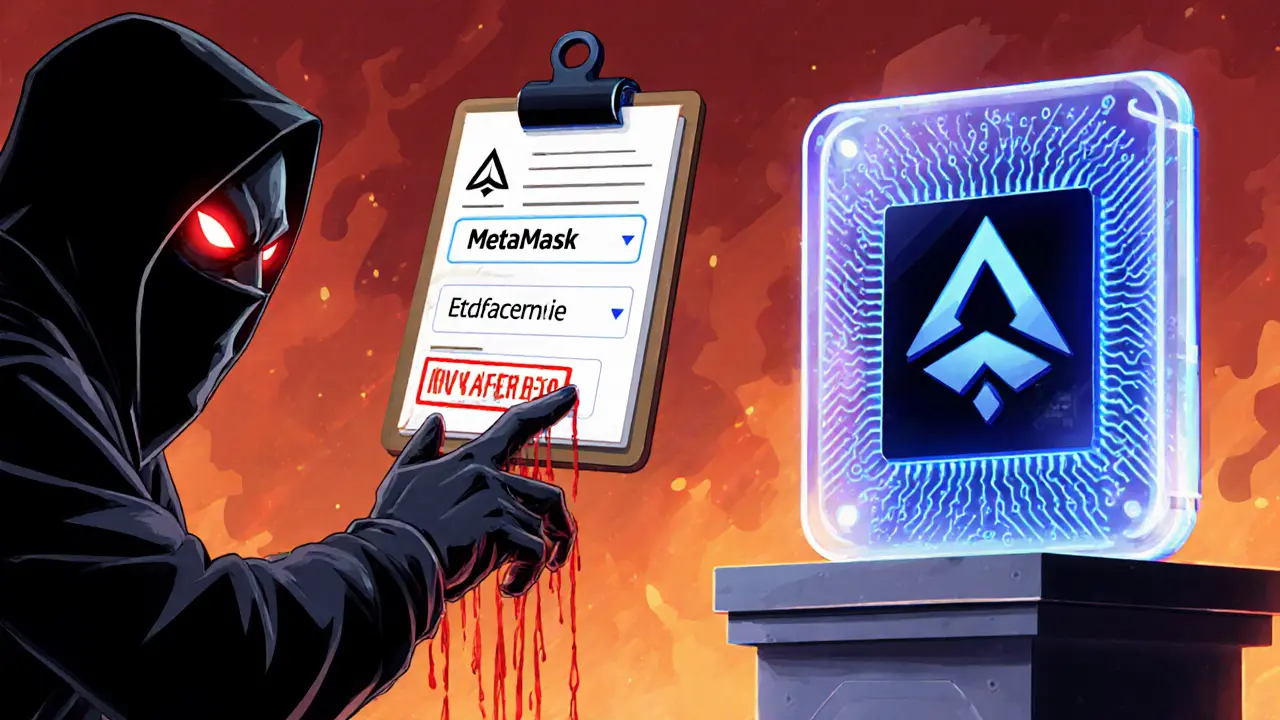Crypto Wallet Security Advisor
When managing crypto assets, Software wallet is a digital application that stores private keys on a device or in a browser, allowing instant transactions and dApp interaction. By contrast, Hardware wallet keeps keys offline in a secure element chip, offering stronger protection at the expense of speed. This trade‑off-convenient access versus robust protection-is the core dilemma for anyone who wants to move, trade, or hold cryptocurrency. Below we break down how software wallets work, why they’re so popular, the security gaps that bother experts, and how to decide which approach fits your risk tolerance.
What Exactly Is a Software Wallet?
A software wallet is any program-mobile app, desktop client, or browser extension-that stores the cryptographic Private key needed to sign transactions. The keys are encrypted, typically with AES‑256, and the wallet is always online (often called “hot storage”). Popular examples include MetaMask, Trust Wallet, Exodus and the open‑source Electrum. Each offers a slightly different user experience, but they share three core traits:
- Keys are stored on the device or in the browser memory.
- Access requires a password, PIN, or biometric factor.
- Recovery relies on a 12‑ to 24‑word Seed phrase that can rebuild the wallet on any compatible app.
How Software Wallets Work Under the Hood
When you install a wallet, the app generates a master seed (the 12‑ or 24‑word phrase). Using BIP‑39 and BIP‑44 standards, that seed creates a hierarchical deterministic (HD) tree of private/public key pairs. The app never sends the seed to a server; it stays encrypted locally. Every time you approve a transaction, the wallet uses the private key to sign a cryptographic proof, which is then broadcast to the blockchain via an internet connection.
Because the wallet is always connected, it can pull real‑time price data, suggest optimal gas fees, and interact directly with decentralized applications (dApps). MetaMask, for example, processes over a million daily transactions and powers most Ethereum‑based DeFi activity. Trust Wallet’s built‑in Web3 browser lets users swap tokens on Uniswap or buy NFTs without leaving the app.
The Convenience Factor
Speed is the biggest selling point. With a software wallet you can:
- Send funds in seconds from your phone or laptop.
- Swap assets on a decentralized exchange (DEX) with a single tap.
- Participate in yield farming, staking, or NFT drops instantly.
- Connect to any dApp-games, DeFi protocols, or decentralized identity services-without plugging in extra hardware.
For day traders and gamers, that immediacy translates into real profit. A survey of active traders on Reddit’s r/CryptoCurrency showed that 78% of respondents prefer software wallets for daily swaps because “waiting for a hardware confirmation feels like a bottleneck.”
Software wallet security: The Hidden Risks
Convenience comes with exposure. Since the keys sit on an internet‑connected device, a compromised phone or PC can leak them to malware. Kaspersky’s 2024 report highlighted three main attack vectors:
- Clipboard hijacking: Malware swaps your copied address with the attacker’s address.
- Phishing dApp clones: Fake sites mimic MetaMask or Trust Wallet interfaces to steal seed phrases.
- Screen‑recording spyware: Captures the seed phrase when you type it during backup.
Browser extensions are especially risky. In 2023, a vulnerability in the Chrome update process affected more than 2million MetaMask users, allowing malicious code injection. Mobile wallets inherit the security posture of the underlying OS-Android’s open ecosystem makes sideloaded malware a real threat, while iOS is safer but still vulnerable to jailbreak exploits.

Software vs. Hardware: A Side‑by‑Side Comparison
| Feature | Software Wallet | Hardware Wallet |
|---|---|---|
| Key storage | Encrypted on device / browser (hot) | Secure element chip, offline (cold) |
| Initial cost | Free (app download) | $59‑$200+ device |
| Transaction speed | Instant, one‑tap confirmations | Requires physical button press, slower |
| Best use case | Active trading, DeFi, NFT minting | Long‑term storage, high‑value holdings |
| Typical risk | Malware, phishing, clipboard attacks | Device loss, supply‑chain compromise |
| Recovery method | 12‑24 word seed phrase (can be cloud‑backed) | Seed phrase + optional passphrase; many support social recovery |
The table makes it clear: if you’re moving small amounts daily, a software wallet wins. If you hold six‑figure positions, a hardware wallet is the safer bet.
Choosing the Right Wallet for Your Needs
Start by asking three questions:
- How much are you planning to spend each month? If it’s under a few hundred dollars, a well‑maintained software wallet is fine.
- Do you need DeFi or NFT access? Most hardware wallets require a bridge app (e.g., Ledger Live) that can be clunky for frequent swaps.
- What’s your threat model? If you’re worried about nation‑state actors or sophisticated phishing, lean toward hardware.
Many users adopt a hybrid strategy: keep a “spending” wallet like MetaMask on their phone for daily swaps, and store the bulk of their portfolio in a Ledger or Trezor device. Andreas Antonopoulos calls this the “hot‑cold” approach and it’s widely recommended by security researchers.
Practical Security Tips for Software Wallet Users
Even though software wallets are inherently riskier, you can dramatically lower exposure by following these habits:
- Enable biometric or PIN protection on the app and on the device itself.
- Activate multi‑factor authentication (MFA) where available-some wallets let you require a second approval via email or a separate app.
- Never store your seed phrase digitally. Write it on paper and keep it in a fire‑proof safe.
- Verify URLs before entering any credentials. Bookmark the official site of MetaMask or Trust Wallet.
- Use a dedicated device for crypto activities-preferably one that doesn’t install random apps.
- Keep the OS and wallet app updated. Security patches fix known exploits.
- Consider a social recovery add‑on. Newer wallet versions let you nominate trusted contacts to approve recovery.
Implementing these steps can cut the chance of loss by up to 70% according to a 2024 BlockSec study that surveyed 1,200 wallet users.

Future Trends in Software Wallets
Developers are racing to close the security gap while preserving convenience. Upcoming advances include:
- Account abstraction on Ethereum, allowing social recovery and multi‑signature without extra contracts.
- Zero‑knowledge proof (ZKP) integrations that hide transaction details from observers.
- Hardware‑backed secure enclaves built into flagship smartphones, creating hybrid wallets that store keys in a protected chip.
- AI‑driven threat detection that warns you if a malicious dApp tries to read your clipboard.
Even with these upgrades, the fundamental fact remains: any wallet that stays online is a “hot” target. Treat software wallets as spend‑only accounts and move large sums to cold storage whenever possible.
Bottom Line
If you value speed, want to experiment with DeFi, or need to buy NFTs on the fly, a software wallet is the obvious choice. Just remember that convenience is a double‑edged sword-your keys sit on a device that can be compromised. Pair the wallet with strong OS hygiene, biometric locks, and a solid backup plan, and you’ll enjoy the best of both worlds. For anything you plan to keep for the long term, lock it in a hardware wallet and only move what you need into the software wallet for active use.
Frequently Asked Questions
Can I use a software wallet on both my phone and laptop?
Yes. Most wallets let you import the same seed phrase on multiple devices, but remember that each device becomes a potential attack vector. Treat every instance as a separate “hot” copy of your keys.
Do hardware wallets work with DeFi platforms?
They do, but usually through a bridge app (e.g., Ledger Live) that signs transactions on the device and then forwards them. This adds latency and can be less user‑friendly than a native software wallet.
Is it safe to back up my seed phrase to iCloud or Google Drive?
Security experts advise against cloud backups. If the cloud account is breached, attackers obtain the seed phrase instantly. Write it down on paper or use a metal seed‑storage device.
What’s the biggest advantage of using MetaMask over Trust Wallet?
MetaMask dominates the Ethereum ecosystem and integrates with most DeFi dashboards, while Trust Wallet supports a broader range of blockchains (65+). Choose MetaMask for deep Ethereum work; pick Trust Wallet for multi‑chain activity.
Should I enable multi‑signature on a software wallet?
Multi‑sig adds a layer of protection by requiring multiple approvals for a transaction. Some wallets now embed this feature natively (e.g., Gnosis Safe integration). It’s worth enabling if you regularly handle large sums.

Michael Grima
October 16, 2025 AT 09:18Software wallets: fast, flaky, and fabulously insecure.
Mandy Hawks
October 18, 2025 AT 00:07One could argue that the allure of instant access mirrors our modern desire for immediacy. Yet the philosophical trade‑off between convenience and sovereignty remains timeless. The wallet, in a sense, is an extension of the self, guarding secrets we entrust to code. By reflecting on this, we may choose tools that align with our deeper values.
Scott G
October 19, 2025 AT 14:57It is imperative to acknowledge the inherent vulnerabilities associated with hot storage. The encryption mechanisms, while robust, are contingent upon the security of the host device. Consequently, any compromise at the operating system level may jeopardize the cryptographic material. Users are advised to adopt a layered defense strategy, encompassing both software and procedural safeguards. This measured approach mitigates exposure without sacrificing functionality.
VEL MURUGAN
October 21, 2025 AT 05:46The recent Chrome extension vulnerability underscores the necessity for rigorous code audits. Empirical data indicates that over two million users were exposed to potential key exfiltration. From a technical standpoint, the lack of sandboxing was the primary failure mode. Implementing hardware‑backed enclaves could substantially reduce the attack surface. Developers should prioritize such mitigations to restore user confidence.
Russel Sayson
October 22, 2025 AT 20:35The crypto world is split between the lightning‑fast allure of software wallets and the stoic guardianship of hardware devices.
When you swipe your phone to approve a trade, you feel the pulse of decentralization at your fingertips.
But that same pulse can become a siren song for malware, luring the unwary into a silent theft.
Hardware wallets, by contrast, demand the physical act of pressing a button, a ritual that reminds you of the value of what you hold.
This friction, though annoying to day‑traders, is the very moat that separates your assets from prying eyes.
Security researchers have documented clipboard hijacking attacks that silently replace your destination address.
Phishing dApp clones multiply daily, each one a mirror reflecting the same deceptive UI.
Even the most diligent user can fall prey if they neglect to verify the URL of a MetaMask prompt.
The principle of defense‑in‑depth suggests that no single layer should be trusted in isolation.
A hybrid strategy-keeping only a small “spending” balance on a hot wallet-embodies this philosophy.
The bulk of your portfolio, especially if it exceeds six figures, should reside in cold storage.
Ledger and Trezor devices have matured, offering firmware updates that patch known exploits.
Yet they are not invulnerable; supply‑chain attacks remain a lingering specter.
Therefore, the prudent user conducts regular audits of both software and hardware configurations.
Backups, stored offline in fire‑proof safes or metal seed vaults, complete the security triangle.
In the end, convenience is a double‑edged sword, and your choice determines whether you wield it as a blade or a shield.
Michael Bagryantsev
October 24, 2025 AT 11:24That’s a solid breakdown; I’d add that rotating the hot wallet address daily can further limit traceability, and keeping the hardware’s firmware up‑to‑date is a habit worth cultivating.
Maria Rita
October 26, 2025 AT 02:13Great points! Just remember: if you treat your software wallet like a checking account and your hardware wallet like a vault, you’ll stay safe while still having the fun.
Jordann Vierii
October 27, 2025 AT 17:02Yo crypto fam, think of your wallet as a gym-software is your cardio, hardware is your weightlifting. Both are essential, but you gotta balance the reps!
Lesley DeBow
October 29, 2025 AT 07:51In the grand tapestry of digital assets, the wallet is the loom that weaves fate and fortune alike. 🤔 Embrace the tools that echo your risk appetite.
DeAnna Greenhaw
October 30, 2025 AT 22:40One must first contemplate the ontological distinction between 'hot' and 'cold' custodial paradigms, lest one err in the pursuit of superficial convenience. The software wallet, a veritable Prometheus of immediacy, bestows upon the user a sense of omnipotent liquidity. Conversely, the hardware counterpart, reminiscent of an archetypal vault, enshrines the principle of prudence. To oscillate indiscriminately between these modes betrays a lack of strategic foresight. A discerning connoisseur shall allocate quotidian operational capital to the former whilst sequestering the lion's share within the latter. Moreover, the evolving cryptographic standards demand vigilant adaptation; neglect is tantamount to intellectual complacency. In this dialectic, the sagacious investor emerges not merely as a participant but as a custodian of digital sovereignty. Thus, the equilibrium of speed and security is not a compromise but a cultivated art.
Luke L
November 1, 2025 AT 13:30While you wax poetic, the reality is that many users lack the time to study such lofty treatises; they just need a reliable device that won’t betray their assets.
Cynthia Chiang
November 3, 2025 AT 04:19Hey there! i think its important to keep your seed phrase safe, like in a fire proof safe or a metal plate. dont store it on cloud, thats a big no no. also, always double check the app youre using is the real one. stay safe!
Hari Chamlagai
November 4, 2025 AT 19:08The glaring truth is that software wallets are a sandbox for hackers; anyone who trusts them for significant sums is practically inviting theft. A hardware wallet, with its secure element, is the only rational choice for serious holders.
Ben Johnson
November 6, 2025 AT 09:57Ah, the eternal love‑hate relationship with hot wallets – love the speed, hate the inevitable phishing emails that follow.
Jason Clark
November 8, 2025 AT 00:46Sure, plug in a tiny USB and feel like a secret agent, but remember you still need to update the firmware or you’re just a glorified paperweight.
Jim Greene
November 9, 2025 AT 15:35Keep the crypto flowing! 🚀 Use a software wallet for daily trades and a hardware vault for the big wins. You’ve got this! 😎
Della Amalya
November 11, 2025 AT 06:24Balancing convenience with security is a journey, not a destination. Embrace the hybrid approach, and you’ll navigate the crypto seas with confidence and grace.
Isabelle Graf
November 12, 2025 AT 21:14Honestly, if you’re not willing to spend a couple of bucks on a Ledger, you probably shouldn’t be holding crypto at all.
Shane Lunan
November 14, 2025 AT 12:03Software is fast but risky.
Jordan Collins
November 16, 2025 AT 02:52The decision matrix should incorporate transaction frequency, asset value, and threat modeling to derive an optimal wallet strategy.
Andrew Mc Adam
November 17, 2025 AT 17:41Listen up! If you’re looking to keep your crypto safe, you gotta treat your hardware wallet like a pet – feed it updates, keep it clean, and never leave it in the rain. On the other hand, your software wallet should be used sparingly, like a tool you only pull out when you need to fix something quick. Mix them together and you’ll have a system that’s both agile and robust. Just don’t forget to write down that seed phrase somewhere safe, because forgetting it is like losing the key to your house.
Shrey Mishra
November 19, 2025 AT 08:30In the grand theater of decentralized finance, the software wallet plays the role of the impetuous protagonist, while the hardware wallet assumes the mantle of the stoic guardian. Both are indispensable to the narrative, yet their scripts diverge dramatically.
Ken Lumberg
November 20, 2025 AT 23:19Enough with the wishy‑washy advice – if you want real security, buy a hardware wallet now and stop treating your crypto like spare change.
Marques Validus
November 22, 2025 AT 14:08Layered security stack synergy leverages multi‑sig escrow protocols alongside cold storage TEE modules to mitigate surface‑area exposure while maintaining transaction throughput latency acceptable for DeFi arbitrage bots